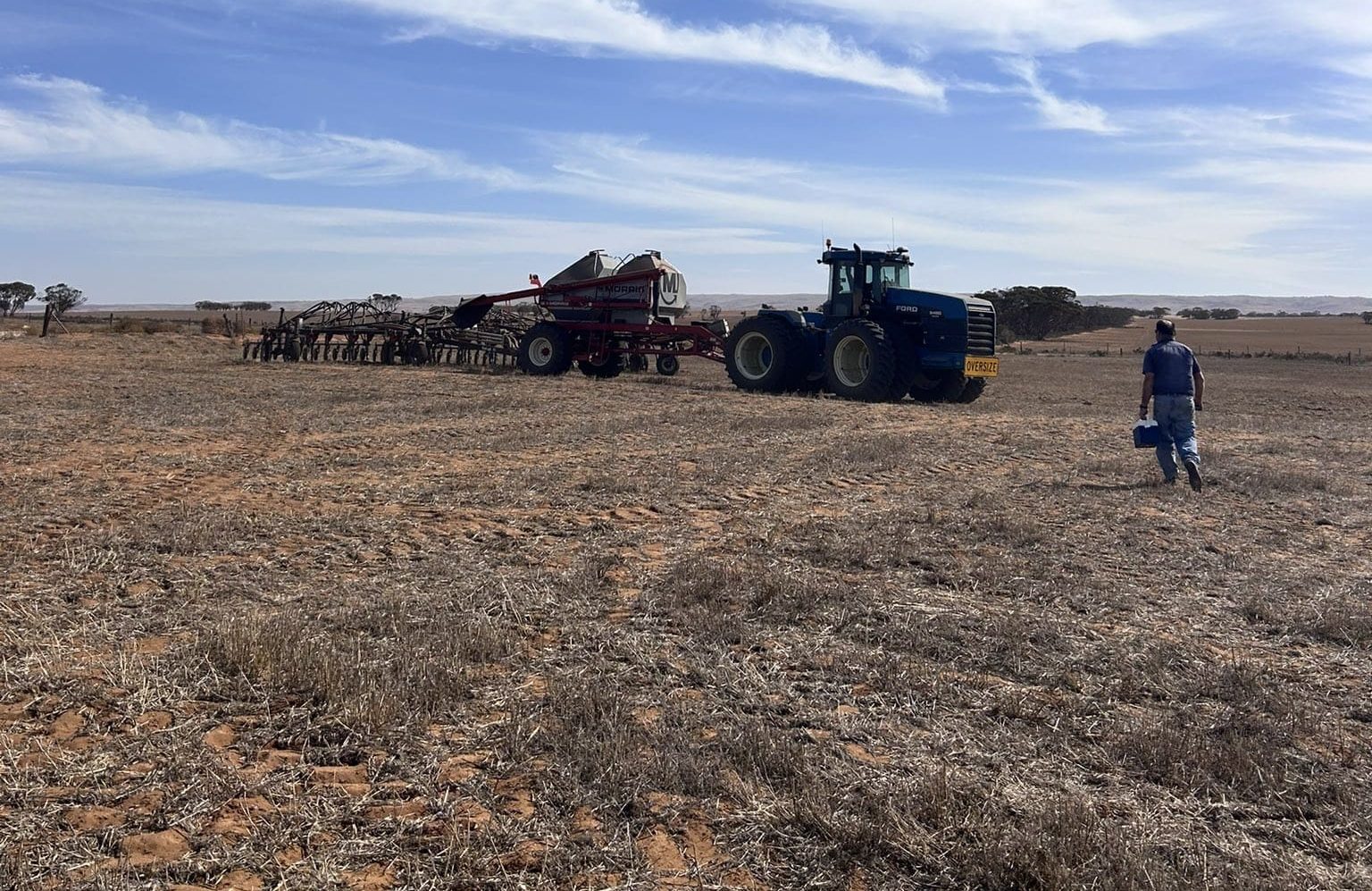
Planting lentils in SA’s Murray-Mallee region, where rain has recently fallen to germinate crops sown dry, mostly in May. Photo: Rebekah Starick
WIDESPREAD rain over the first weekend of June has boosted prospects for Australia’s new-crop lentils, and a mostly ideal season in northern growing regions is seeing planting of chickpeas continue at pace.
Offsetting the rosy conditions in the north for chickpeas and faba beans, and an improved outlook for lentils in South Australia and Victoria are flat markets for chickpeas and lentils.
Both are now subject to tariffs in the major market of India, and demand from other destinations is modest at present.
On faba beans, domestic demand for their inclusion in livestock rations is mopping up much of what is left in traders’ hands after a hectic export program.
Chickpeas
In its quarterly Australian crop report released June 3, ABARES forecast Australia’s new-crop chickpea production at 1.88 million tonnes, down from the record 2.27Mt harvested last season.
Many growers in northern NSW and southern and central Qld have finished planting, and others are close to it in mostly ideal conditions.
However, some parts of NSW’s outer north-west plains have been too wet to allow all intended area to be planted.
Some growers will not finish planting chickpeas until the end of the month, and chickpeas planted in heavier country are only just starting to emerge.
| CHICKPEAS | 2024-25 ha | 2024-25 tns | 2025-26 ha | 2025-26 tns |
| Qld | 420,000 | 950,000 | 430,000 | 790,000 |
| NSW | 580,000 | 1,280,000 | 590,000 | 1,050,000 |
| Vic, SA, WA | 38,500 | 37,000 | 37,500 | 37,500 |
Table 1: Area and production estimates by state for 2024-25 and 2025-26. Source: ABARES
Bulk demand for chickpeas has dwindled, with new-crop bids at around $730/t delivered Brisbane port, down from $860/t seen in early May.
A number of new-crop cargoes are believed to have been sold, particularly out of CQ, where harvest starts early and quality is sought-after, and bids are stronger than those into Brisbane.
“Everyone’s gone short; growers are not selling” one trader said.
“At the moment, I don’t see grower selling unless there’s an eight in front of the number.”
Australian chickpeas into India are now subject to a 10-percent tariff, which on current price projections makes on-farm prices for new-crop lucky to pass $600/t.
“Sentiment is bearish; everyone thinks there will be plenty of chickpeas.”
Current-crop stocks have dwindled after a huge shipping program which slowed markedly in March, and bulk demand has contracted to Pakistan, with buying from Bangladesh expected to kick in soon.
“Pakistan is the only one buying…and Bangladesh will be in the market around August.”
“With Ramadan in February, they want chickpeas to arrive by Nov-Dec.”
Faba beans
ABARES has forecast faba bean production at 680,000t from 399,000ha, down from 749,500t from 401,000ha in 2024-25.
Crops in southern Qld and the northern half of NSW generally got off to a flying start on ample subsoil and topsoil moisture in the ideal window which allowed establishment in April and May.

A crop of faba beans sown in the Walgett district of north-west NSW and photographed May 20. Photo: Greg Rummery
In contrast, many crops in Vic and SA are only germinating now, but may well achieve or exceed average yields if weather is kind between now and harvest.
While recent rain in SA, Vic, and southern NSW has bolstered prospects for spring grazing, faba beans are still in strong demand from the livestock sector after many months of handfeeding sheep and cattle continues.
| FABAS | 2024-25 ha | 2024-25 tns | 2025-26 ha | 2025-26 tns |
| Qld | 19,000 | 37,000 | 16,000 | 28,000 |
| NSW | 160,000 | 400,000 | 170,000 | 300,000 |
| Vic | 120,000 | 180,000 | 110,000 | 170,000 |
| SA | 90,000 | 110,000 | 85,000 | 153,000 |
| WA | 12,000 | 22,500 | 18,000 | 29,000 |
Table 2: Faba bean area and production estimates by state for 2024-25 and 2025-26. Source: ABARES
Pellet manufacturers and graziers are paying around $650/t ex farm, while the bulk market is paying $620/t delivered port for cargoes still to load.
The delivered port market has dropped $20-$30/t from May, with key buyer Egypt seen as well stocked ahead of Northern Hemisphere new crop.
“Faba business is starting to dry up,” one trader said.
“The stuff that was booked to be shipped in June-July is being pushed out to August.
“Egypt has plenty of faba beans.”
Lentils
Prospects for Australia’s new-crop lentils have improved enormously following at least 20mm of rain this month to date across most of SA and Vic’s major growing areas.
After what for some growers has been the driest 15 months on record, the rain has arrived at the same time as cool to cold weather.
Crop establishment has been slow, but growers are feeling more confident about the season as successive rain events start to come through.
“Where they were just coming through they’ve really bounced out now with the rain, where they haven’t, they’re just starting,” ETG trader Todd Krahe said last week.
“By the weekend, there should be a green tinge.”
Grower selling is expected to pick up by September, provided prospects for an average yield remain in sight.
New-crop lentils are nominally trading at a discount of around $100/t to the prompt market to reflect subdued demand from South Asia.
However, Bangladesh and Sri Lanka are providing solid support for what little tonnage is hitting the prompt market, and trading at around $800/t delivered Wimmera packer.
Since April 1, lentils arriving in India have been subject to an 11-percent tariff.
Under the Australia-India Economic Cooperation and Trade Agreement, a 50pc rebate is available on a first-come first-served basis on 37,500t of lentils per quarter, with any unused quota rolling into the following quarter.
Therefore, one or two cargoes per quarter of Australian lentils look likely to be shipped for the foreseeable future.
| LENTILS | 2024-25 ha | 2024-25 tns | 2025-26 ha | 2025-26 tns |
| Qld | 1,300 | 1,500 | 1,100 | 1,200 |
| NSW | 35,000 | 50,000 | 30,000 | 30,000 |
| Vic | 520,000 | 650,000 | 470,000 | 555,000 |
| SA | 530,000 | 750,000 | 476,000 | 690,000 |
| WA | 10,500 | 16,000 | 15,000 | 21,000 |
Table 2: Lentil area and production estimates by state for 2024-25 and 2025-26. Source: ABARES
Classification framework furthered
Adding to the varietal classification framework being refined for lentils, Grains Australia is close to finalising a national framework for faba beans, and work has commenced on a framework for lupins.
Varietal classification frameworks add value to the Australian pulse industry through enabling differentiation based on inherent quality characteristics desired by customers.
The new Grains Australia Pulse Varietal Classification Technical committee met for the first time in April.
It will consider applications for classification and assess the quality of pulse varieties against the technical requirements of classes.
Grain Central: Get our free news straight to your inbox – Click here

HAVE YOUR SAY